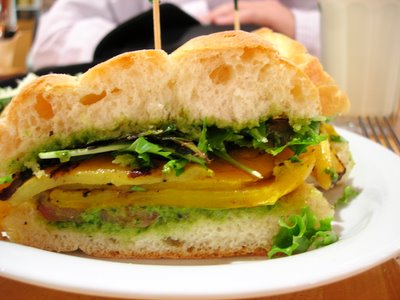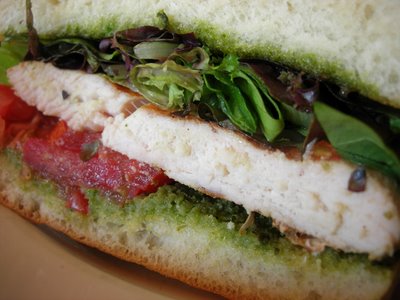
Escaping the teriyaki chicken: how to get the most out of your sushi experience
Sushi is my favorite non-dessert food, but often I have a hard time finding someone to share a meal of raw fish with. My friends are usually either scared of it, turned off by it, or intimidated by not knowing what anything is or how to eat it. Or sometimes they’re very eager, but they embarrass me with their complete disregard for sushi etiquette. Others like sushi, but have yet to stray far from the safety of California rolls and yellowtail.
When I first forayed into the raw fish frontier, I could not find much information online about how to eat sushi properly. Now, I know a fair amount about sushi and sushi and sushi etiquette, so whether you're a newbie or an old fan, I'd like to share my tips for getting the most out of your sushi experience.
I’ll skip the bar versus table debate, since I’ve already explained that here. So let’s talk about deciphering the menu. Sashimi is just thin slices of fish (about ¼”) served alone, without rice. Nigiri is a thicker piece of fish, about 2 inches in length, served atop a small rectangle of rice. And maki is rolled sushi, which is probably what you think of when someone talks about sushi—seaweed wrapper on the outside, followed by rice, then fish and/or vegetables in the middle. When you order maki (which is usually described as a roll on the menu, so that’s easy), you can have it two ways: you can get a cut roll, which is what you are probably expecting, or you can get a hand roll, which is where the seaweed is rolled into the shape of a cone and not cut. In my opinion, hand rolls are difficult to bite (seaweed is quite tough) and awkward and messy to eat. Some rolls, like the softshell crab roll, look better presented this way, however. When you order a roll, you’ll get 6 or 8 pieces, and when you order nigiri, you’ll always get two pieces. An order of sashimi is generally 5 or 6 pieces.
As far as the actual names of the fish themselves, they are usually written in English, so that shouldn’t be a problem. But just because you can read “yellowtail” doesn’t mean you have any idea what it tastes like. I could try to explain all of the flavors to you, but wouldn’t it be more fun if you let yourself be surprised? Just make sure you know if it's shellfish or not, if you (or your date) are allergic.
If you’re new to sushi, I have a few suggestions for things that are less scary. Not all sushi contains raw fish. Some rolls, like cucumber rolls or avocado rolls, just contain vegetables. These rolls also tend to be smaller and easier to eat in the requisite one bite (more on that later). Then there are rolls that contain cooked fish, like California rolls, which have veggies and crab meat, if you’re lucky, or more commonly (depending on the caliber of restaurant you’re at) veggies and fake crab meat, which is often made from a bland, inexpensive white fish called pollock that is then flavored to taste like crab. Be warned—if you are allergic to shellfish, you should not eat imitation crab—it does usually contain trace amounts of real crab. To avoid raw fish, you could also try anything with shrimp in it, since the shrimp will be cooked, such as a shrimp tempura roll, which contains fried shrimp and vegetables.
If you want to try nigiri but are afraid of faw fish, try a piece of eel. Eel is not slimy at all, and is cooked. It is also often heavily glazed with a teriyaki-like sauce (eel sauce), so it doesn’t even taste like fish. There are two kinds of eel, saltwater and freshwater. Oddly enough, the saltwater eel will be the fresher of the two--freshwater eel is generally cooked and packaged in Japan and then flown to the U.S. As a beginner, you will probably appreciate either one, though having had my share of sushi, I'm a little sick of saucy freshwater eel, and think saltwater eel, served plain with just a hint of sea salt and citrus, is sublime. If you are ready to explore raw fish, try yellowtail (hamachi), which has a mellow flavor and smooth texture. Or, you can do what I did the first time I had sushi, and go straight for the octopus.
I’ve tried pretty much everything that isn’t shellfish (I’m allergic, so no shrimp, crab, lobster, or sea urchin for me). In case you were wondering about some of the more daring things on the menu, I’ll tell you about a few. Giant clam is smooth, slightly sweet,and very crunchy. Who knew fish, let alone raw fish, could be so crunchy? I have only had it once, and I didn’t think it tasted like much, but I’d recommend trying it just to experience the bizarre texture. I found octopus to be chewy and very salty. I think it is probably only good when prepared by the best of chefs, so don’t bother unless you’re dining somewhere spectacular. Another interesting experience is to get salmon roe or herring roe—large or small fish eggs. These are listed with the nigiri, and served in twos, but are shaped more like rolls. A seaweed wrapper on the outside and a layer of rice on the bottom are used to create a sort of bowl which is then filled with fish eggs and sometimes topped with wasabi. Salmon roe are larger, and pop and gush when you bite into them, while herring roe are crunchy and tiny enough to get stuck in your teeth. Both are very salty, partly because they are almost always packed in salt and shipped from Japan. If you are lucky, you may be able to get fresh eggs (read: not packed in salt) when they are in season. These taste much better, as their saltiness is much more subdued.
As if the experience of 50-200 raw fish eggs in your mouth wasn’t enough, you can also get either of these with a raw quail egg cracked on top. The quail egg is very runny and salty, yet somewhat sweet. The experience isn't as horrifying as you might think, but personally it is not something I feel compelled to repeat, though I'm glad I did it.
If you just want to get through the evening without embarrassing yourself, I have a few suggestions. Do not put ginger on top of your sushi. The flavors of sushi are delicate, while pickled ginger has a very strong flavor. The purpose of the ginger is actually to cleanse your palette between different kinds of fish—essentially, to get rid of the flavor you just tasted so it won’t interfere with the next, distinct flavor. So if you put it on your fish, you’re negating that $3-5 morsel you’re about to put in your mouth, and horrifying the chef and everyone around you.
Second, when you create your soy sauce dish, only put in a little bit of soy sauce—preferably reduced sodium, again to preserve the flavor of the fish and not detract from it. Technically, you are not supposed to put wasabi in the dish—yes, everyone does it, and yes, they’ve given you a huge glob of the stuff, which makes it seem like you’re supposed to use it. A good sushi chef actually applies wasabi to the fish for you, if he thinks there should be any at all. Personally, I hate this practice—I think there is always too much wasabi, and it’s all in the middle part of the fish. Eating too much wasabi will really make your brain burn, and if you’re me, will result in you shaking your head back and forth violently until it goes away. I prefer to mix my wasabi and soy sauce and dip my fish in it.
Contrary to what you might think, saturating your soy sauce with as much wasabi as possible does not make you hard core—it makes you look like a beginner, and it means that, again, you’re destroying the flavor of your sushi. You'll never use anywhere close to the whole glob of wasabi--it's just there for show. Or something.
When dipping a piece of nigiri into soy sauce, you turn it upside down and dip the fish side in. If you dip the rice side, the rice will soak up too much of the soy sauce. If you’re dipping a roll, get it in and out quickly, and definitely don’t plunk it into the bowl and leave it there to marinate. You’re trying to compliment the flavor, not drown it out
Then there is the chopstick question. When do you use them, and when don’t you? You use chopsticks to eat sashimi. You don’t use them to eat nigiri. And you usually use them to eat maki, but it is somewhat more acceptable to use your hands if you feel so inclined. It is also somewhat difficult to pick up a large roll with your chopsticks if you are a beginner. The best way to learn to use chopsticks, though, is to force yourself to use them through an entire meal. It will be frustrating, and will take a long time, but will also take you far in learning to use them.
Chopsticks have an eating end and a serving end. The narrower end is for taking food from your plate to your mouth. The wider end is for taking something from a communal plate to your plate, for example, if you’re nabbing a dab of wasabi or a few slices of ginger. Also, don’t rest your chopsticks on the table. Ideally, you'll have a chopstick rest, like a small stone or ceramic animal, but most places don't bother with these, it seems. I usually rest mine on the wasabi dish, though I don't know if this is kosher.
Another important thing about sushi is that it is meant to be eaten all in one bite. I question this often, since almost every piece of sushi that comes my way is way too big for my mouth. Rolls are extremely difficult to bite into though, because seaweed is so tough. Nigiri and sashimi are easier to get away with taking bites of—and you’ll look less uncouth doing this if you don’t put the fish back on your plate between bites. Though I can see the purpose of eating the sushi all in one bite, especially if it’s a roll with different ingredients, or a chewy fish that resists being neatly bitten in half, I don’t see how having a mouth so full of fish that I can barely chew is supposed to enhance my experience.
These guidelines are designed to enhance your eating experience—though some of them, like not leaving unappetizing half-bitten hunks of raw fish on your plate, and using the serving end of your chopsticks when appropriate, are also meant to please those that share your meal. Ultimately, eating sushi is about sheer pleasure, so eat whatever kind of sushi you want in whatever way is most pleasing to you—or if you really can’t handle the fish, just order the teriyaki chicken.
On Eating at the Sushi Bar
















